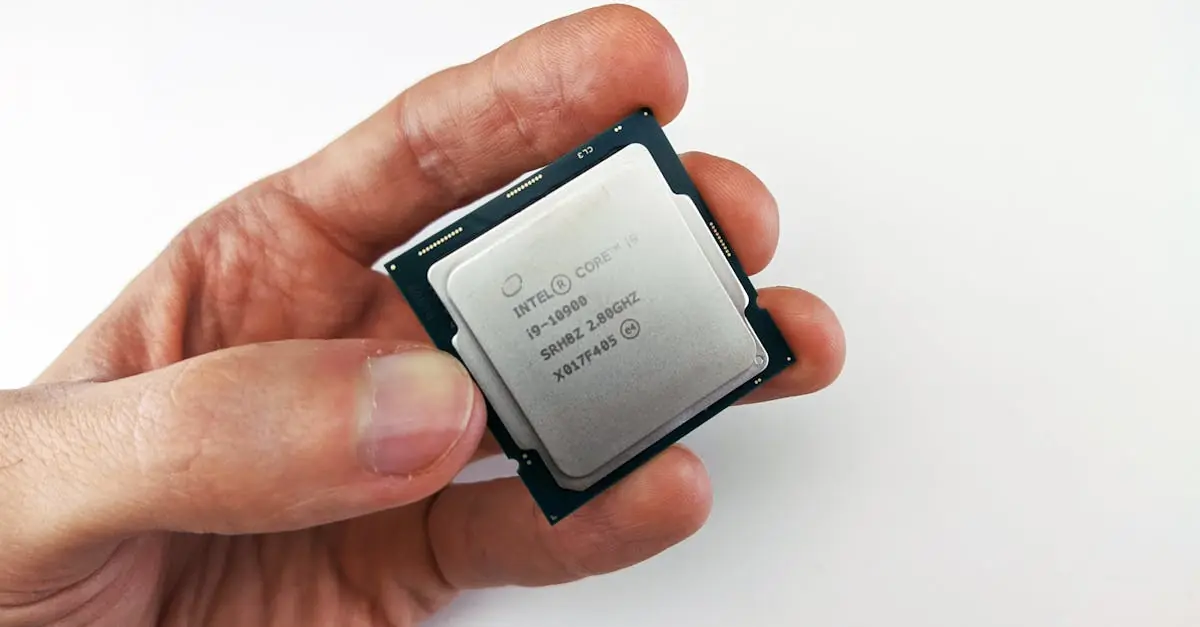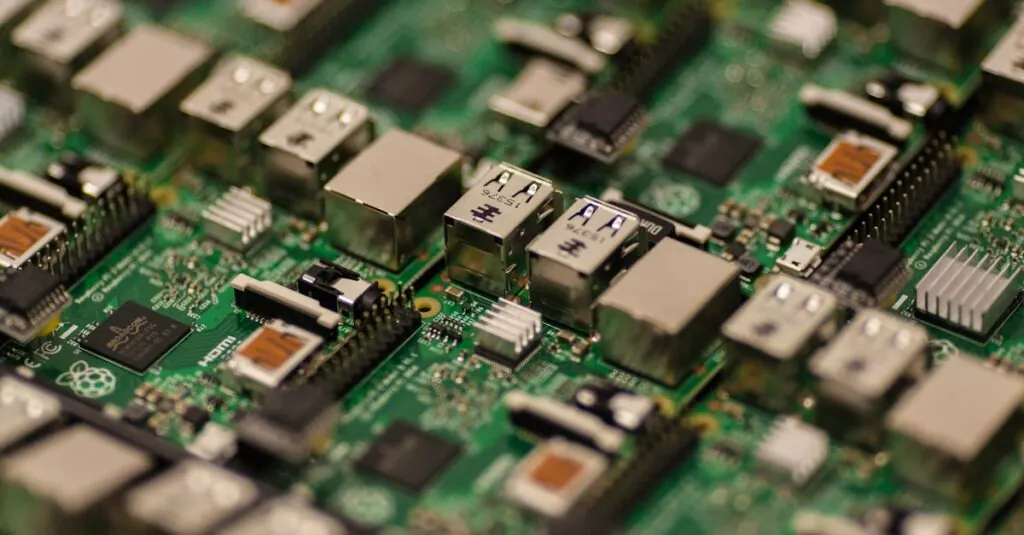Table of Contents
ToggleIn today’s digital age, everyone’s got data—lots of it. From family photos to that secret stash of cat memes, keeping everything organized and accessible can feel like herding cats. Enter the NAS system, your trusty sidekick in the battle against digital chaos. But before diving headfirst into the world of Network Attached Storage, it’s crucial to understand what makes a good NAS tick.
Understanding NAS System Specs
Network Attached Storage (NAS) serves as a vital solution for managing data efficiently. Understanding the specifications of a NAS system helps users make informed decisions about their storage needs.
What is a NAS?
A NAS is a dedicated data storage device connected to a network, enabling multiple users and devices to retrieve and store data remotely. It operates independently without reliance on a connected computer. Users can access files via various devices, like laptops or smartphones, through simple interfaces. The configuration often includes multiple hard drives for redundancy and data protection. Some models integrate additional features like media streaming and data backup, enhancing their functionality beyond mere file storage.
Importance of Specs in NAS
NAS system specifications directly influence performance, usability, and data management capacity. Factors such as processor speed, memory size, and drive type significantly affect data transfer rates and multitasking abilities. A powerful processor enhances data processing efficiency, while adequate RAM supports seamless multi-user access. Drive configurations, such as RAID setups, offer varying levels of data protection and speed. Specifying these details ensures compatibility with user needs and future-proofing against evolving demands. Evaluating specs supports optimal performance and helps prevent potential bottlenecks in data access.
Key Specifications to Consider
Selecting the right NAS system involves examining various specifications that ensure optimal performance. Focusing on storage capacity, processor power, RAM specifications, and network interface capabilities is essential.
Storage Capacity
Storage capacity defines how much data a NAS can hold. Many systems offer varying sizes, ranging from a few terabytes to dozens of terabytes. For users with large media collections or extensive backups, opting for higher capacities is crucial. Some NAS devices allow for additional drives, which enables easy expansion. Evaluating current and future storage needs helps in making a well-informed choice.
Processor Power
Processor power influences a NAS’s ability to handle tasks efficiently. Modern NAS devices typically utilize multi-core processors, allowing for better multitasking and faster data processing. A robust processor enhances application performance and supports simultaneous file transfers, benefiting multiple users. Users requiring advanced features like transcoding benefit from higher clock speeds and better architectures. Always consider the processor specifications when selecting a NAS for demanding applications.
RAM Specifications
RAM specifications play a significant role in NAS performance. More RAM leads to faster data access and improved overall system responsiveness. Many entry-level NAS units come with 2GB or 4GB of RAM, which may suffice for basic functions. Upgrading RAM is advisable for users running multiple applications or managing large databases. Systems that support higher RAM provide more headroom for complex tasks, enhancing the user experience.
Network Interface Capabilities
Network interface capabilities determine how quickly data transfers occur within the network. Most NAS devices come with Gigabit Ethernet ports, allowing for fast connections. Some advanced models offer dual or multi-port configurations for increased bandwidth and redundancy. Users with high demand for data streaming should consider NAS devices that support link aggregation for improved performance. Always check the network specifications to ensure compatibility with existing infrastructure.
Advanced Features of NAS Systems
NAS systems offer various advanced features that enhance data management and user experience.
RAID Support
RAID support is crucial for data redundancy and performance. Different RAID levels like RAID 1, RAID 5, and RAID 10 provide unique benefits. NAS systems typically allow users to choose the RAID level that fits their needs, balancing performance and data protection. Using RAID configurations, data is mirrored or striping across multiple drives, minimizing the risk of data loss in case of a drive failure. Enhanced performance results from both read and write operations being distributed evenly across the drives.
Data Backup and Recovery Options
Data backup and recovery options provide assurance against unexpected data loss. Most NAS systems offer automated backup solutions, such as scheduled backups or real-time synchronization with connected devices. Snapshots allow users to capture the state of their data at specific intervals, providing multiple points to restore from. Advanced models may support cloud backup, enabling off-site storage and additional security. Combating data loss through these features adds peace of mind for individuals and businesses alike.
Multimedia Capabilities
Multimedia capabilities elevate the NAS experience, especially for home users. Most NAS devices support various media formats, enabling seamless streaming of photos, music, and videos. Built-in media servers can convert files in real-time, enhancing compatibility with different devices. Users can access their multimedia libraries on smart TVs, mobile devices, and gaming consoles. Streaming high-definition content without buffering enhances user satisfaction, making NAS systems valuable for entertainment purposes.
Choosing the Right NAS for Your Needs
Selecting the ideal NAS system depends on user requirements and budget. Various factors influence this decision, including intended use and available funding.
Home Use vs. Business Use
Home users typically require simpler NAS systems for basic file storage and media streaming. Features like easy setup and multimedia support enhance the experience for families sharing photos and videos. In contrast, businesses often need more robust systems. Enhanced performance, increased storage capacity, and redundancy through RAID configurations serve critical data management needs. Organizations may prioritize security options and extensive user access controls, ensuring data integrity and protection. Understanding the difference in requirements helps users choose a system that matches their specific situation.
Budget Considerations
Setting a budget is essential when selecting a NAS system. Prices vary significantly based on features and capacities. Entry-level options start around $200, suitable for light home use. Mid-range models usually range from $400 to $800, meeting small business needs with added functionality. High-end systems cost upwards of $1,000, supporting large data volumes and complex configurations. Users should consider long-term expenses as well, such as additional storage drives, which can increase overall investment. Evaluating these financial aspects ensures a well-rounded decision aligned with individual or organizational goals.
Conclusion
Choosing the right NAS system is a pivotal decision for anyone looking to efficiently manage their digital data. By understanding the key specifications such as storage capacity processor power and RAM users can tailor their choice to fit specific needs. Whether for home use or business applications a well-selected NAS can enhance data accessibility and security while providing a seamless user experience.
Investing time in researching these specifications ensures that users not only meet their current requirements but also prepare for future data demands. With the right NAS system in place users can enjoy peace of mind knowing their valuable data is well-managed and protected.




